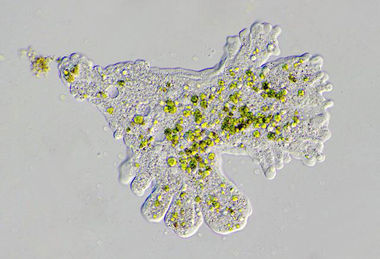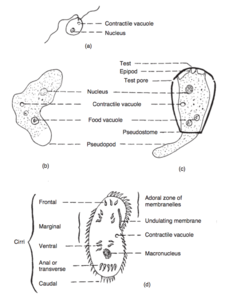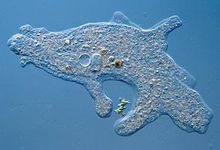Naked amoebae: Difference between revisions
| Line 9: | Line 9: | ||
It is common for this variety of soil protozoa to be found in the [[rhizosphere]] due to the abundance of bacterial flora surrounding the plant root zones. | It is common for this variety of soil protozoa to be found in the [[rhizosphere]] due to the abundance of bacterial flora surrounding the plant root zones. | ||
=='''Movement & Anatomy'''== | =='''Movement & Anatomy'''== | ||
[[File: Protists.png| | [[File: Protists.png|240px|thumb|left|Figure 2- adapted from Figure 4.5 - "Morphology of four types of soil protozoa: (a) flagellate (Bodo); (b) naked amoeba (Naegleria); (c) testacean (Hyalosphenia); (d) ciliate (Oxytricha) [6]."]] | ||
Differing from [[testacean| Testate Amoeba]], which have a hard shell, [[Naked amoeba|Naked Amoeba]] do not. | Differing from [[testacean| Testate Amoeba]], which have a hard shell, [[Naked amoeba|Naked Amoeba]] do not. | ||
Amoebae are polymorphic; a single cell can adopt very different shapes, especially when it is stationary or moves in a non-coordinated manner, often changing the direction of locomotion. They move and feed through the use of [[pseudopods]], which are bulges of cytoplasm formed by the coordinated action of actin microfilaments pushing out the plasma membrane that surrounds the cell. | Amoebae are polymorphic; a single cell can adopt very different shapes, especially when it is stationary or moves in a non-coordinated manner, often changing the direction of locomotion. They move and feed through the use of [[pseudopods]], which are bulges of cytoplasm formed by the coordinated action of actin microfilaments pushing out the plasma membrane that surrounds the cell. | ||
Revision as of 14:29, 5 May 2021

Definition
A Naked Amoeba is a taxonomic classification of soil protozoa found in a variety of agricultural, grassland, and forested soils. These are the most voracious of all the soil protozoa and the most dominant in numbers, including a variety of species. Naked Amoeba, as well as other protozoans, exploit tiny microhabitats that are unavailable to other larger soil organisms, such as "Nematodes". Like other soil protozoa, they promote soil decomposition by enhancing bacterial metabolism, consuming excess bacteria, and excreting simple compounds utilized by plants.
Habitat
Naked Amoeba make up a large portion of microfauna in a variety of soil habitats. The reason for their higher populations in soil is most likely due to the fact that their sliding motion on surfaces enable them to feed on the soil particles, where most of the bacteria grow, and their highly flexible cells are well adapted for grazing activities within the thin water films surrounding the soil particles [4].
Also due to their shape and size, they are easily able to reach very small cavities or pores in the soil aggregates and feed on bacteria that would otherwise be inaccessible to predators [5]. It is common for this variety of soil protozoa to be found in the rhizosphere due to the abundance of bacterial flora surrounding the plant root zones.
Movement & Anatomy

Differing from Testate Amoeba, which have a hard shell, Naked Amoeba do not. Amoebae are polymorphic; a single cell can adopt very different shapes, especially when it is stationary or moves in a non-coordinated manner, often changing the direction of locomotion. They move and feed through the use of pseudopods, which are bulges of cytoplasm formed by the coordinated action of actin microfilaments pushing out the plasma membrane that surrounds the cell.
Dietary Processes
Naked Amoeba are phagotrophic, meaning they engulf the entirety of the organism in order to digest it. Phagocytosis involves the process of the amoeba extending its pseudopods and then creating a vacuole of the food within its cytoplasm, which it then digests using enzymes before releasing the processed material into the surrounding environment.

They can consume a variety of food sources, such as bacteria, fungi, algae, and other fine particulate matter in soils. A majority of bacteria consumed in soil is conducted by Naked Amoeba, as they are the most abundant and most efficient at decomposing bacteria.
Reproduction
These organisms reproduce asexually via fission, the splitting of one cell, or via syngamy, which is the fusion of two cells.
References
[1] Coleman, D.J., Callaham, M. A., Jr., Crossley, D.A.. November 2017. 'The Fundamentals of Soil Ecology'. Third Edition. Elsevier Academic Press.
[2] Singleton, Paul. 2006. 'Dictionary of Microbiology and Molecular Biology'. 3rd Edition. John Wiley & Sons. https://archive.org/details/dictionarymicrob00sing_558
[3] Bamforth, S.S. 1980. 'Terrestrial protozoa'. J. Protozool. 27, 33–36. https://doi.org/10.1111/j.1550-7408.1980.tb04227.
[4] Clarholm, Marianne . 1981. 'Protozoan Grazing of Bacteria in Soil--lmpact and Importance'. Microbial Ecology.7, p. 343-350. [5] Foster, R.C., Domar, J.F.. 1991. 'Bacteria-grazing amoeba in situ in the rhizosphere'. Biol. Fertil. Soils 11, p.83-87.
[6] Louiser, J.D., Bamforth, S.S.. 1990. 'Soil Protozoa'. Soil Biology Guide. Wiley, New York, p. 97-136.